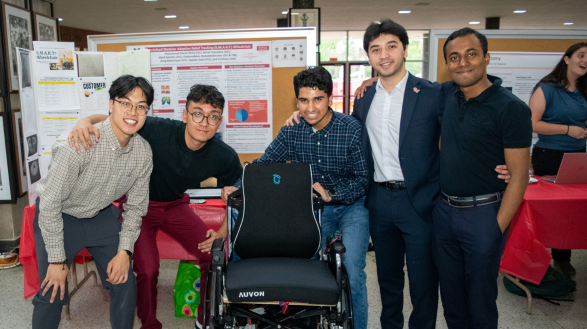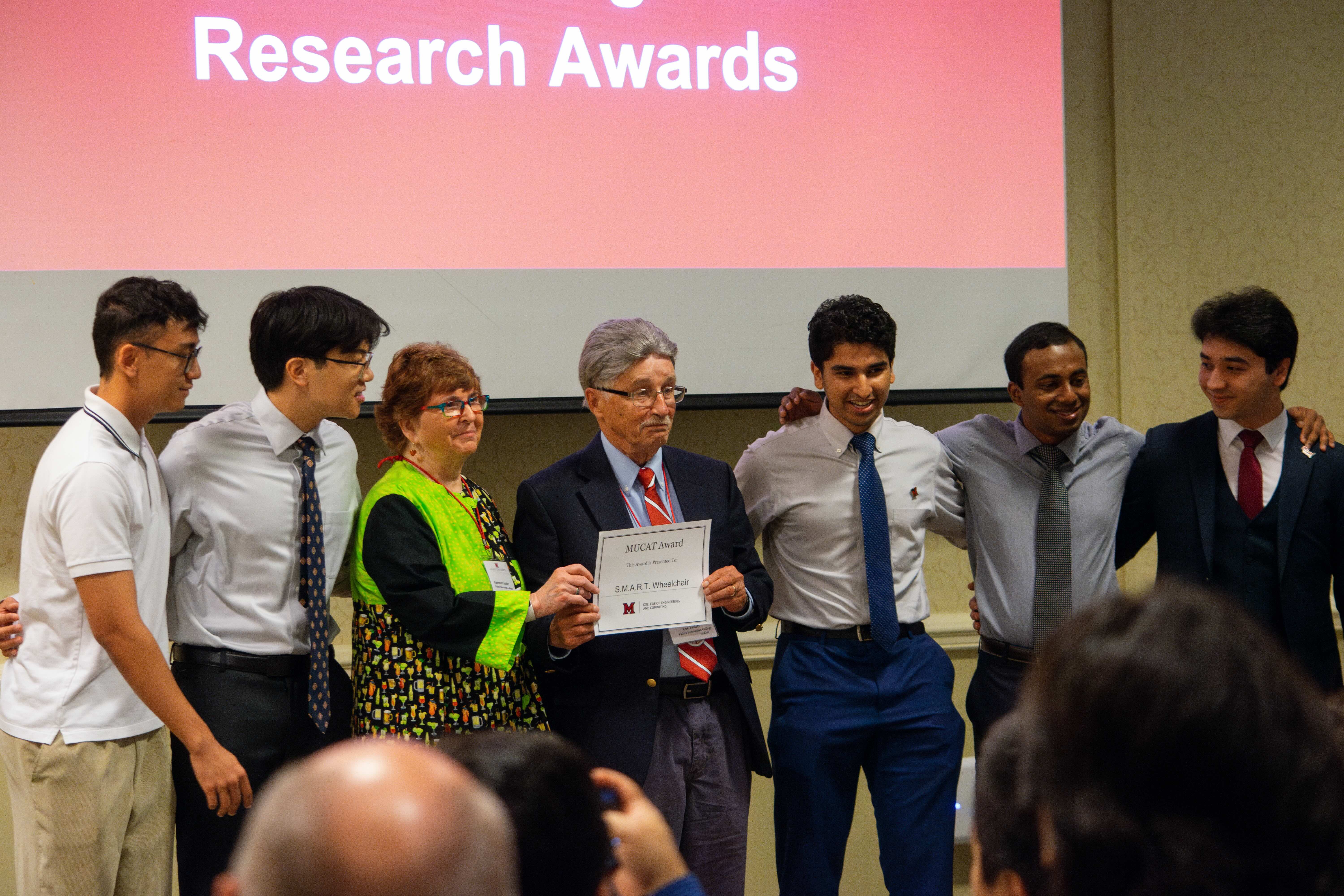Students win $25,000 to advance affordable, user-informed wheelchair design
This year’s MUCAT award winners are redefining mobility with a motorized wheelchair designed for affordability, comfort, and real-world usability

Students win $25,000 to advance affordable, user-informed wheelchair design
College of Engineering and Computing students are developing a wheelchair to improve access to essential mobility equipment for those who need it.
The group–made up of Muhammad Danish Malik, Micah Granadino, Abud Hamdan, Shakhzodkhon Mukaddaskhonov, Aung Khant Kyaw, Sajjadur Sajid, and Jack Purtiman–designed a prototype device that retrofits onto existing manual wheelchairs.
The Specialized Modular Adaptive Relief Tracking wheelchair, or SMART wheelchair for short, adds motorized elements to standard manual wheelchairs, which saves wheelchair users from having to buy entirely new and expensive motorized wheelchairs.
“(Our design) gives users greater independence and reduces the physical burden on caregivers, while making essential mobility more accessible to those who need it most,” Malik said.
The SMART wheelchair also features pneumatic standing assistance, making the transition from sitting to standing easier, as well as an integrated pressure relief system. The latter helps prevent pressure ulcers from developing due to prolonged sitting, according to the team.
“Priced at $6,000, our system delivers electrified movement, standing assistance, and pressure relief—three crucial functionalities—in one affordable package,” Granadino said.
Many wheelchair models inclusive of these features can cost upwards of $20,000 or more, according to various electric wheelchair retailers.
Not wanting to over-engineer the wheelchair, the group made sure to work with Student Disability Services and get feedback from wheelchair users across campus, targeting the most poignant issues with standard motorized wheelchairs, they said.
After building an initial prototype for their SMART wheelchair, the group showed off their hard work and innovation at the CEC Design Expo.
“We had many people stop by our booth to ask questions about how our wheelchair worked, and some even wanted to try it out themselves!” Granadino said. “Seeing that kind of interest from others made me see the value of our design in helping individuals who really need it.”
The SMART wheelchair design earned the team top prize in the Miami University Center for Assistive Technology (MUCAT) competition at the expo. MUCAT works with students and faculty across campus to research and innovate assistive technology.
 Lee and Rosemary Fisher celebrated with the award-winning team at CEC's Alumni and Friends conference on May 2.
Lee and Rosemary Fisher celebrated with the award-winning team at CEC's Alumni and Friends conference on May 2.
This year’s competition was a collaboration between MUCAT and The Lee and Rosemary Fisher Innovation Fisher Innovation College@Elm. College@Elm serves as an anchorpoint between the university and community partners, a position leveraged to connect students in the competition with partners including the Department of Defense, start-ups, and the Veterans Association.
As this year's MUCAT Design Challenge Award winner, the SMART wheelchair team secured $25,000 to move forward with their design. The $25,000 prize was made possible through the support of College@Elm, and will serve as a “launchpad” for accessibility, according to the team.
“It gives us the momentum and resources to transform our vision into a fully functional, real-world solution,” Malik said. “With this support, we’re building a lighter, more scalable second prototype by machining better parts from aluminum, integrating real-time pressure sensors, and developing an adjustable seat tailored to users’ comfort and health.
After making practical upgrades to the second prototype in the coming school year, the students plan to begin beta testing their invention at local assisted living facilities and VA hospitals. They are also working toward a solid marketing campaign as well as a legal strategy for protecting their design and eventually partnering with investors.
With many steps ahead to see the project through, the group said they’re excited about the work they’ve put in and what they have learned from it.
“We came together as a group of friends with a shared vision and had to figure things out from scratch, building basic prototypes, learning through trial and error, and staying motivated through setbacks,” Malik said. “There were late nights and a lot of moments where we had to figure things out on the fly, but in the end, putting in the work and seeing it come together made it all worth it.”
Even more, they’re humbled by the impact their design may make on their community and beyond.
“It's the beginning of something that has the potential to make independence, comfort, and mobility more accessible for the people who need it most,” Granadino said.